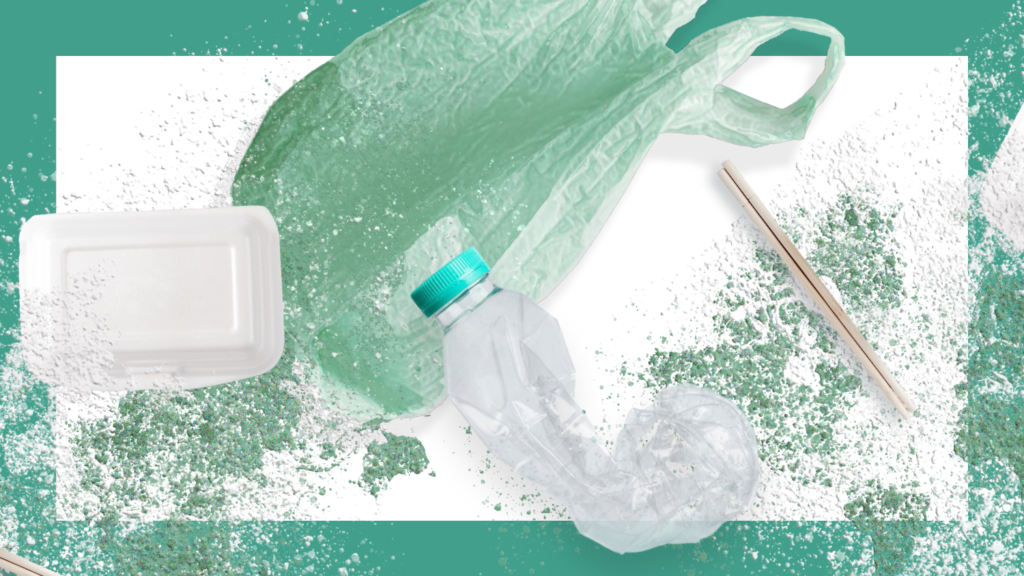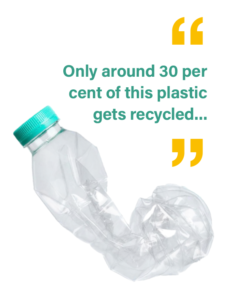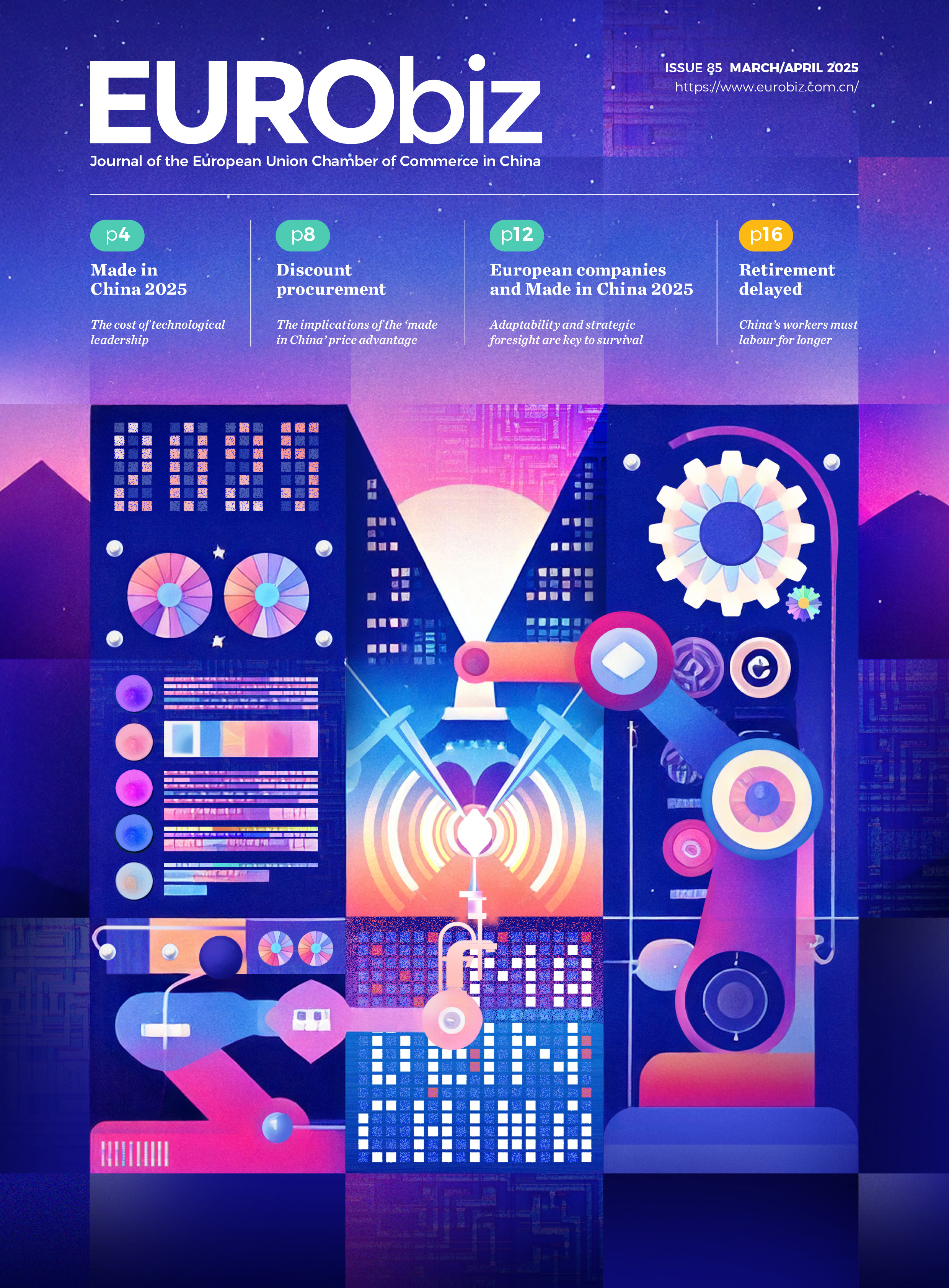
Managing the F&B industry’s environmental impact
China’s food delivery industry is the largest in the world. In the space of a decade, its exponential growth has transformed the food and beverage (F&B) sector, and the convenience of innovative mobile platforms has made delivery a part of daily life in Chinese cities. In 2020, a game-changing year for the industry, 17 billion orders were delivered throughout China.[1]
On the flip side of the industry’s success is the large volume of plastic waste that it generates. Despite efforts to phase out single-use plastics (SUP), production and use are still rising. Food delivery accounts for half of the total SUP use in China and generated 1.6 million tonnes of plastic waste in 2020 alone.[2] Only around 30 per cent of this plastic gets recycled; the rest is buried in landfills or incinerated.
As China continues to strengthen its environmental regulations, in line with its commitment to reach peak carbon dioxide (CO2) emissions before 2030 and achieve carbon neutrality by 2060, the food delivery industry faces mounting pressure to reduce waste and move towards a circular economy model. This creates new opportunities for European companies that offer sustainable solutions essential to shaping the sector’s future.
Green commitments in the regulatory framework
In recent years, China has revised its key environmental laws and introduced a series of policies aimed at curbing emissions and promoting sustainability. While some of the regulations have a broad scope covering pollution and public health, others target the F&B industry’s role in reducing plastic waste.
In the first group, the 1989 Environmental Protection Law was revised in 2014 with stricter penalties for polluters. The Law on the Prevention and Control of Solid Waste Pollution, introduced in 1995 and revised in 2020, does not explicitly mention F&B but restricts the production, sale and use of non-biodegradable bags. It also requires takeaway platforms to report their use and recycling of disposable plastic products.[3]

Targeting F&B waste specifically, in 2021 the Anti-food Waste Law prohibited restaurants from promoting overconsumption and encouraged businesses to adopt waste-reduction policies or face fines for violations. A year earlier, the Opinions on Further Strengthening Plastic Pollution Control and the Notice on Further Strengthening Plastic Pollution Control in the Commercial Sector had already banned single-use plastic straws in catering nationwide, followed in 2022 by a ban on single-use utensils, and a stated goal of cutting the use of disposable plastic by 30 per cent in catering and takeaway food by 2025.[4]
The current 14th Five-year Plan (2021–2025) (14FYP)includes an Action Plan for Plastic Pollution Control with policy recommendations to further improve the management of the entire chain of plastic pollution by eliminating single-use plastics, encouraging recycling and promoting alternatives to plastic to effectively curb ‘white pollution’.[5]
Enforcement and fragmentation issues
Since the turn of the decade, delivery platforms have taken action to incorporate more sustainable practices. For instance, with ‘nudge measures’, consumers are made to opt in to receive disposable cutlery instead of cutlery being included as a default. Many restaurants have replaced plastic containers and straws with biodegradable alternatives derived from plant fibres. However, such changes still fall short.
Although the regulations are strict and potential penalties steep, in practice, many local authorities struggle to enforce them. Weak enforcement has so far been the highest hurdle. An example of this is often visible inside delivery bags. Even when consumers select the no-cutlery option, many businesses provide it anyway. Restaurants have to process orders quickly and do not want to be exposed to the risk of negative reviews from users who had opted in to receive utensils. For the same reason, takeout containers are often tightly wrapped in extra layers of plastic packaging film, as any spill could trigger a bad review and lower a restaurant’s ranking on the platforms, leading to fewer orders.
Overlapping responsibilities also make effective environmental oversight difficult. The Ministry of Ecology and Environment (MEE) deals with industrial pollution, while the State Administration for Market Regulation (SAMR) oversees food safety and formulates standards. Local environmental protection bureaus also play a role in monitoring compliance.
This fragmentation can lead to unclear accountability. Businesses may face conflicting regulatory requirements, creating confusion and compliance failures. For European small and medium-sized enterprises interested in the market, navigating this complex landscape can be daunting without local expertise or partnerships.
Recycling challenges
Food delivery currently relies on several types of plastic, which makes sorting and recycling more complex. One of the most recyclable types of plastic is the polythene terephthalate (PET) used for bottles and clear containers, but it makes up only about 15 per cent of SUP use in China. Polystyrene (PS) is convenient for lightweight foam containers; although technically recyclable, it easily breaks into pieces, making collection and recycling more difficult. Durable and heat-resistant polypropylene (PP), found in 60 per cent of the disposable plastic used in the industry, is also recyclable. However, like PET and PS, its actual recycling rates do not exceed 30 per cent.[6]
Food-grade recycled PET (rPET) requires high purity levels, which sophisticated recycling plants can achieve. However, rPET for food contact applications remains under fragmented regulations in China, with unclear standards on decontamination and cleaning. The commercialisation of food-grade rPET is still pending approval in the country.
Some other green options introduced in recent years bring their own issues to the table. Corn starch-based boxes can replace PP containers and be incinerated without causing a spike in carbon emissions. However, the environmental gains from using degradable meal boxes depend directly on their disposal conditions. Similarly, the phasing out of ultra-thin plastic bags, initially in first-tier cities and later in all urban areas, has led many businesses to turn to non-woven bags. However, these bags are harder to break down. They only become eco-friendly if they are reused many times, not if they are provided with each new delivery order.
Food contamination adds another layer of difficulty to the F&B sector. When containers are mixed with kitchen waste, additional cleaning steps and costs bring recycling rates down. Many recycling plants cannot effectively process plastics soiled with oils or sauces. In practice, this means that many recyclable containers end up in landfills or incinerators.
Overall, cost remains a significant barrier. Down the line, recycling can benefit F&B businesses directly, helping them reduce waste disposal fees and allowing for the recovery of valuable materials. Currently, however, producing virgin plastic is cheaper.
In the case of rPET, industry experts estimate that achieving price parity with virgin plastic will remain difficult for the next decade.[7] However, the photovoltaic experience has shown that large-scale production and incentives can quickly make a product more competitive. Ultimately, cost reduction will be key to the mass adoption of sustainable alternatives to disposable plastics.
Key drivers and areas with potential
With the commitment of reaching peak emissions before 2030 and achieving carbon neutrality by 2060, China is explicitly encouraging foreign investment in sectors such as waste reduction, waste management and recycling, as detailed in the 2022 Catalogue of Encouraged Industries for Foreign Investment released by the National Development and Reform Commission and the Ministry of Commerce.[8] Incentives include tax rebates, administrative support and favourable land-use terms.
In F&B, actions towards a circular economy model will need to consider the whole value chain. This means giving priority to reducing inputs and minimising waste, with reusable and returnable products. The plastic used by the F&B industry could be recycled into new food-grade containers, which could be achieved using the ‘bottle-to-bottle’ closed-loop system for rPET used in other parts of the world.
Many companies in the European Union (EU) and China have become specialised in producing food-grade rPET. However, in the absence of regulations permitting its use in food-contact materials in China, the rPET produced in the country is either used in textiles, fibres and non-food packaging, or is exported to other markets.
Other areas with growth potential include product designs that consider the reusability of plastic products and solutions to make packaging fully recyclable, for instance, with washable inks and shrink sleeves that can be directly processed with PET. Waste-to-energy solutions and technologies for high-level physical recycling and chemical recycling will also be part of a more sustainable F&B industry in the coming years.
Even in encouraged sectors, navigating the market requires proper planning to comply with the relevant standards and obtain the necessary licences and certifications. Due to their direct impact on public health, most standards related to the F&B sector are mandatory. Several, but not all, are based on international ISO standards, which can contribute to making European entities well placed in the market. Benefitting from years of experience in European markets with a relatively high demand for green solutions and the need to comply with stringent EU regulations on sustainability and safety, many European companies have developed an edge and patented new recycling technologies over the past decade. However, they need to be prepared to compete with fast-developing Chinese companies. Industry players should closely monitor regulatory developments and be ready to act as changes take place.
This article is based on a recent report by the EU SME Centre, ‘Waste Reduction and Recycling in China’s F&B Sector’. You can download the full report at: https://www.eusmecentre.org.cn/wp-content/uploads/2024/11/Report-Waste-Reduction-in-FB-2024.pdf
About the EU SME Centre
The EU SME Centre is an initiative funded by the European Union under the Single Market Programme (SMP). The EU SME Centre provides a comprehensive range of first-line support services to European small and medium-sized enterprises (SMEs), assisting them to establish, develop, and maintain commercial activities in the Chinese market. The Centre’s resources include a Knowledge Centre, a Training Centre, an Advocacy Platform, and an Ask-the-Expert enquiry service offering information and confidential advice to European SMEs. Find out more on the EU SME Centre’s website: www.eusmecentre.org.cn.
[1] Waste Reduction and Recycling in China’s F&B Sector, EU SME Centre, 27th November 2024, viewed 25th March 2025,<https://www.eusmecentre.org.cn/publications/waste-reduction-and-recycling-in-chinas-fb-sector/>
[2] Wen, Z, and Zhang, Y, Mapping the environmental impacts and policy effectiveness of takeaway food industry in China, Science of the Total Environment, Volume 808, 2022, viewed 25th March 2025, ScienceDirect, <https://www.sciencedirect.com/science/article/abs/pii/S0048969721070996>
[3] Law of the People’s Republic of China on the Prevention and Control of Environmental Pollution by Solid Waste, State Council, 30th April 2020, 25th March 2025, <https://www.gov.cn/xinwen/2020-04/30/content_5507561.htm>
[4] Opinions on Further Strengthening the Control of Plastic Pollution, National Development and Reform Commission, 19th January 2020, viewed 25th March 2025, <https://www.ndrc.gov.cn/xxgk/zcfb/tz/202001/t20200119_1219275.html>
[5] Notice of the National Development and Reform Commission and the Ministry of Ecology and Environment on Printing and Distributing the Action Plan for Plastic Pollution Control in the 14th Five-year Plan, State Council, 8th September 2021, viewed 25th March 2025, <https://www.gov.cn/zhengce/zhengceku/2021-09/16/content_5637606.htm>
[6] Managing Plastic Waste in the People’s Republic of China, Asian Development Bank, June 2023, viewed 25th March 2025, <https://www.adb.org/sites/default/files/publication/891876/managing-plastic-waste-prc.pdf>
[7] Unlocking Green Opportunities: China’s F&B Waste Reduction and Recycling Market, EU SME Centre, 12th March 2025, viewed 25th March 2025, <https://www.eusmecentre.org.cn/publications/unlocking-green-opportunities-chinas-fb-waste-reduction-and-recycling-market/>
[8] Catalogue of Encouraged Industries for Foreign Investment (2022 Edition), State Council, 26th October 2022, viewed 25th March 2025, <https://www.gov.cn/zhengce/zhengceku/2022-10/28/content_5722417.htm>


Recent Comments